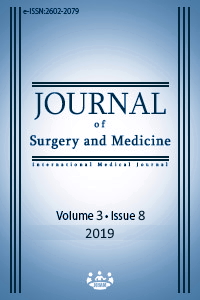Ultrasonographically marked catheterization of internal jugular vein in intensive care patients: Retrospective cohort study
Keywords:
Ultrasound, Internal jugular vein cannulation, Intensive careAbstract
Aim: This study was designed to compare the method of internal jugular vein (IJV) catheterization with prior ultrasonographic (USG) skin marking with the conventional method regarding the performance of a less experienced practitioner in learning ultrasonographic manipulation and safely performing the cannulation.
Methods: The records of patients admitted to the Intensive Care Unit of Ataturk Pulmonology and Thoracic Surgery Training and Research Hospital between April and September 2018 were retrospectively examined. 14 female and 26 male patients (n=40) whose IJV cannulations had been performed with the two above-mentioned methods were included in the study. The practitioner was theoretically trained by an experienced radiologist before the cannulation.
Results: The success rate was 65% in the conventional group and 95% in the USG skin-marked group; the difference was statistically significant (P=0.019). The mean time from the first entry of the needle to the skin to the placement of the catheter in successful cannulations in conventional and USG-marked methods were 110.6(25.6) and 121.6(28.3) seconds, respectively. There was no statistically significant difference (P=0.22).
Conclusion: This study shows that educating the inexperienced practitioner about the use of USG in IJV cannulation and successful application of skin marking method is important.
Downloads
References
Karakitsos D, Labropoulos N, De Groot E, Patrianakos AP, Kouraklis G, Poularas J, et al. Real-time ultrasound-guided catheterisation of the internal jugular vein: a prospective comparison with the landmark technique in critical care patients. Crit Care. 2006;10(6):162.
Hermosura B, Vanags L, Dickey MW. Measurement of pressure during intravenous therapy. JAMA. 1966;195:181.
Daily PO, Griep RB, Shumway NE. Percutaneous internal jugular vein cannulation. Arch Surg. 1970;101:534-6.
Rao TLK, Wong AY, Salem MR. A new approach to percutaneous catheterization of the internal jugular vein. Anesth. 1977;46:362-4.
Hayashi H, Ootaki C, Tsuzuku M, Amano M. Respiratory jugular vasodilation: a new landmark for right internal jugular vein puncture in ventilated patients. J Cardiothorac Vasc Anesth. 2000;14:40-4.
Hosokawa K, Shime N, Kato Y, Hashimoto S. A randomized trial of ultrasound image–based skin surface marking versus real-time ultrasound-guided internal jugular vein catheterization in infants. Anesth. 2007;107(5):720-4.
Bart GD, Uretsky BF. Anatomical variations of internal jugular vein location: impact on central venous access. Crit Care Med. 1991;19(12):1516-9.
Fujiki M, Guta CG, Lemmens HJ, Brock-Utne JG. Is it more difficult to cannulate the right internal jugular vein in morbidly obese patients than in nonobese patients? Obes Surg. 2008;18(9):1157-9.
Hideaki H, Amano M. Does ultrasound imaging before puncture facilitate internal jugular vein cannulation? Prospective randomized comparison with landmark-guided puncture in ventilated patients. J Cardiothorac Vascular Anesth. 2002;16(5):572-5.
Downloads
- 1403 1788
Published
Issue
Section
How to Cite
License
Copyright (c) 2019 Oral Menteş, Mustafa Özgür Cırık, Meriç Ünver, Sema Avcı, Güler Doğanay, Ali Alagöz
This work is licensed under a Creative Commons Attribution-NonCommercial-NoDerivatives 4.0 International License.
















